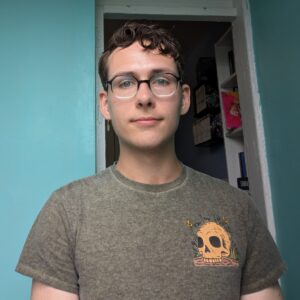My name is Aidan Malanoski (they/them). I am a PhD candidate in linguistics at the CUNY Graduate Center.
Research interests
Variation in American English
I’m a variationist sociolinguist who studies American English, particularly that of the Mid-Atlantic and New York City. My dissertation research focuses on language variation and change in Baltimore, MD, an understudied city. I’m particularly interested in the relationship between race and language variation: despite a long history of racial segregation (which is often argued to lead to linguistic differences between Black and white speakers; e.g., Labov 2010; Duncan 2018; Kohn 2018; Durian, Reynard & Schumacher 2022), there are a number of apparent linguistic similarities between Black and white Baltimoreans, such as fronted GOOSE, fronted MOUTH, and raised THOUGHT. Thus, a goal of my research is to shed light on the factors that lead to linguistic similarity—or difference—across racial lines. I’m also interested in how race intersects with place in mediating language variation and change. By examining how Black and white Baltimoreans use a partially shared repertoire of features in constructing place identity, I hope to shed light on the circulation of place indexicality (meaning related to place) across racial lines.
In addition to my dissertation research, I’m currently working with Bill Haddican and some of our students to investigate mergers of CURE in American English. While mergers of CURE with FORCE (so that poor and pore become homophones) have been documented since at least Kurath & McDavid (1961), we have found that CURE participates in other mergers as well. For some speakers, the CURE class becomes disyllabic, so that tour rhymes with doer. For others, a subset of CURE words merge with NURSE, so that surely becomes homophonous with Shirley. To our knowledge, this surely-Shirley merger has only been reported by Guenter (2000) and Thomas (2001, 2008), while the tour-doer merger has only been reported by Thomas (2001). Both have yet to receive detailed investigation.
Performed language
A second research interest is the use of language in performance, with an eye towards what this reveals about (i) language users’ linguistic knowledge and (ii) the social meaning of linguistic features. Mostly recently, I have been investigating performances of “Baltimorese” (a local term for white working-class Baltimore English) by performers at Baltimore’s HonFest. HonFest, which had its final iteration in 2023, was an annual festival in Baltimore honoring the “Hon,” an exaggerated representation of (mainly white) working-class women from 1950s and 1960s Baltimore (think Edna Turnblad from Hairspray, or check out these three commercials; the name Hon comes from the term of endearment hon, which is a stereotype of Baltimorese). The main event of HonFest was the Best Hon Contest, in which contestants performed as Hons, donning elaborate costumes and adopting Baltimorese accents, and competed for the title of Baltimore’s Best Hon. I have presented work on these Hon performances at NWAV, the LSA, and LAVIS.
Externalization
In addition to my sociolinguistic research, I also work as a syntactician. My syntax research mainly focuses on the syntax-phonology interface: basically, how do we get from syntactic structures to phonological ones? In previous work, I have investigated the linearization of right node raising constructions (e.g., Darius found __ and Jasmine took the book), and I am currently working on projects addressing the formalization of linearization and Vocabulary Insertion. I am collaborating with Jason Kandybowicz on some of this research.
Name
I pronounce my last name [ˌmɛləˈnɑski] (me-luh-NAH-skee, if you like an English-dictionary-style transcription), although I view [ˌmæləˈnɑski] (ma-luh-NAH-skee) as an acceptable spelling pronunciation. Please do not pronounce the penultimate syllable with the MOUTH vowel (e.g., [ˌmæləˈna͡ʊski] ma-luh-NOU-ski).
